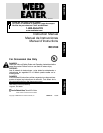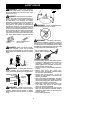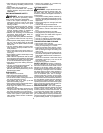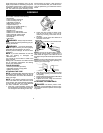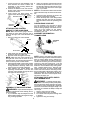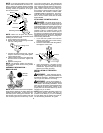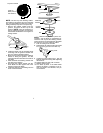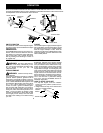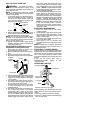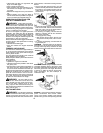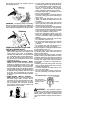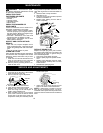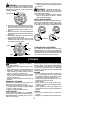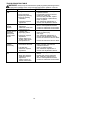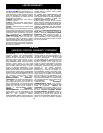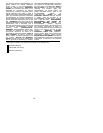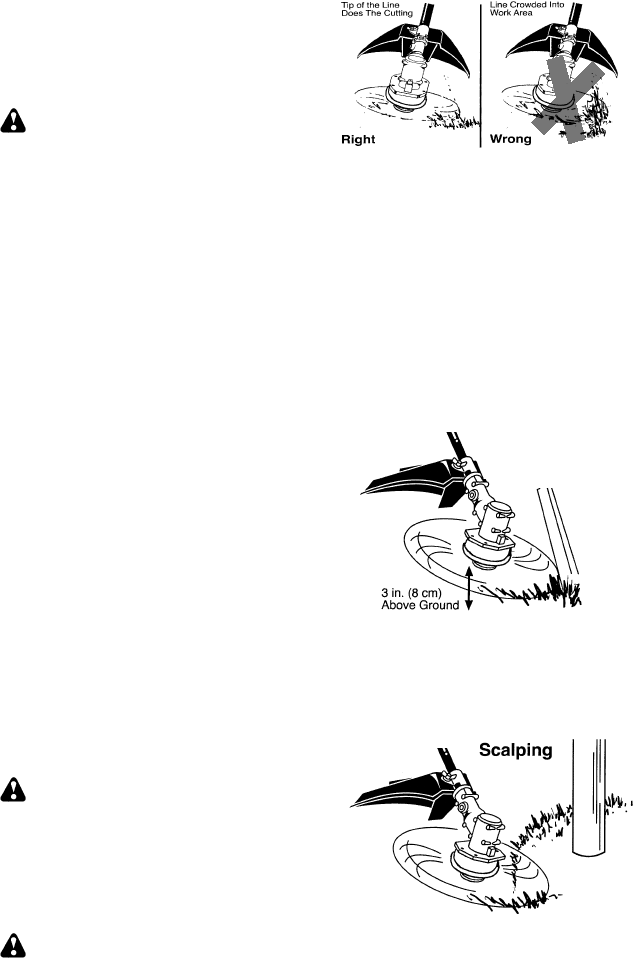
10
S
Hold throttle grip with your right hand with
finger on throttle trigger.
S
Keep unit below waist level.
S
Keep shoulder strap pad centered on your
left shoulder and danger sign centered on
your back.
S
Maintain full weight of tool onyour leftshoul-
der.
S
Without bending over, keep the blade or
trimmer headnearand parallel to theground
and not crowded into material being cut.
OPERATING INSTRUCTIONS FOR
USE WITH TRIMMER HEAD
WARNING:
Always wear eye protec-
tion. Neverl eanoverthetrimmerhead.Rocksor
debris can ricochet or be thr own into eyes and
face andcauseblindnessorother seriousinjury.
Before trimming, bring engine toa speed suffi-
cient to cut m aterial to be trimmed.
Do not run t he engine at a higher speed than
necessary. The cutting line will cut efficiently
whenthe engineisrun atlessthanfull throttle.At
lower speeds, there is less engi ne noise and
vibration. The cutting line will last longer and will
be less l ikely to “weld” onto the spool.
Always release the throttle trigger and allow the
engine to return to idle speed when not cutting.
To stop engine:
S
Release the throttle trigger.
S
Push and release the engine ON/STOP
switch.
TRIMMER LINE ADVANCE
The trimmerline will advance approximately 2
in. (5 cm) each time the bottom of the trimmer
head is tapped on the ground with the engine
running at full throttle.
The m ost e f ficient line l ength is the maximum
length allowed by t he line limiter .
Always keep the shield in place when the tool is
being operated.
To advance line:
S
Operate the engine at full throttle.
S
Hold the trimmer head parallel to and above
the grassy area.
S
Tapthe bottom of thetrimmerhead lightly on
the ground one time. Approximately 2 in. (5
cm) of line will be advanced with each tap.
Always tapthetrimmerhead onagrassyarea.
Tapping on surfaces such as concrete or as-
phalt can cause excessive wear t o the trim-
merhead.If the lineis worndownto2inches(5
cm)orless, more than one tap will berequired
to obtain the most efficient line length.
WARNING:
Use only 0.080
!
(2mm)
diameter line. Other sizes of line will not ad-
vance p roperly and can cause serious injury.
Do not use other materials such as wire,
string, rope, etc. Wire canbreak off duringcut-
ting and become adangerous missile that can
cause serious injury.
CUTTING METHODS
WARNING:
Useminimum speed and
donotcrowdthe linewhencutting around hard
objects (rock, gravel, fence posts, etc.), which
candamage thetrimmerhead, become entan-
gled intheline, orbe thrown causing aserious
hazard.
S
The tip of the line does the cutting. Yo u will
achieve the bestperformance andminimum
line wear by not crowding the line i nto the
cutting area. The right and wrong ways are
shown below.
S
The line willeasily remove grass andweeds
from around walls, fences, trees and flower
beds, but it also can cut the tender bark of
trees or shrubs and scar fences.
S
For t rimming or scalping, use less than full
throttle to increase line life and decrease
head wear, especially:
S
During light duty cutting.
S
Near objects around which the line can
wrap such as small posts, trees or fence
wire.
S
For mowing or sweeping, usefull throttle for
a good clean job.
TRIMMING
-- Ho ld the bottom of the trimme r
head about 3 in.(8 cm)above theground andat
an angl e. A llow only the t ip of the l ine to make
contact. Donotforcetrimmerlineintoworkar ea.
Trimming
SCALPING
-- The scalping technique removes
unwanted veget ation down to the ground. Hold
the bottomof thetrimmerheadabout 3in.(8cm)
above the ground and at an angle. Allow the tip
of the line to strike the ground around trees,
posts, monuments, etc. This technique in-
creases line wear.
MOWING
--Yourtrimmerisideal formowing in
places conventional lawn mowers cannot
reach. In the mowing position, keep the line
parallel totheground. Avoidpressing thehead



